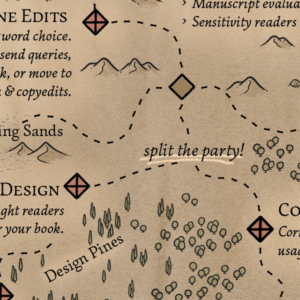 If you picked the self-publishing fork in the road after the Line Edit Foothills, it’s time to split your book journey party. You’ve got multiple quest objectives, and you can accomplish some of them at the same time if you plan it right. Right now you need to do two things: polish your manuscript and put together the graphic design pieces that make your book visually delightful.
If you picked the self-publishing fork in the road after the Line Edit Foothills, it’s time to split your book journey party. You’ve got multiple quest objectives, and you can accomplish some of them at the same time if you plan it right. Right now you need to do two things: polish your manuscript and put together the graphic design pieces that make your book visually delightful.
Polish the Manuscript
The Red-Ink Woods of copyediting are the last place your book goes as a manuscript (after copyediting, it gets reskinned for page proofs/galleys, then on to publishing!). Copyediting cleans up errors in continuity, grammar, usage, and word choice, and it tidies up the manuscript for the typesetter. This is one part of your journey where you want someone who’s looking at the trees, not the forest.
You can have a copyeditor working on your manuscript while you start working with designers—just make sure to tell your interior designer not to lay out the full text or copyfit anything yet.
Establish the Book’s Look
Cover designers and interior book layout designers can both begin their work without the fully polished manuscript. The uncopyedited manuscript—plus your pitch, comp titles, and other design-brief information—will be enough to get them started. Your cover designer can create a front cover long before you’re done editing if you give them appropriate briefing information and a trim size to aim for.
Your book layout designer—if they aren’t the same person as your cover designer—will usually want to see at least some of what the cover designer is doing before they get to work. The cover is your book’s primary marketing tool, and although the book layout doesn’t need to match the cover 100 percent, it should never clash with it. Your layout designer can look over your uncopyedited manuscript to get an idea of what you’ll need and can prepare some sample designs before you finalize the text.
Help Along the Way
At this stage, your questing cohort grows. Here are the folks you should recruit:
- A copyeditor: Look for someone who knows their style guide (for books it’s usually The Chicago Manual of Style) but respects author voice and style, especially in the fluid world of fiction.
- A cover designer: Look for someone who understands trends and typography styles in your genre.
- A layout designer/typesetter: Look for someone who puts readability above all other concerns (but who has style while they’re at it). Sometimes this is the same person who did your cover and sometimes it’s somebody else—both team setups work.
If you want to run through the Design Pines and the Red-Ink Woods at the same time, have different people do the editing and the design, even if you can find a professional with both skill sets.
Where to Next?
After the party splits, the Design Pines and the Red-Ink Woods are the next terrain features on your Book Journey Map.




Leave a Reply